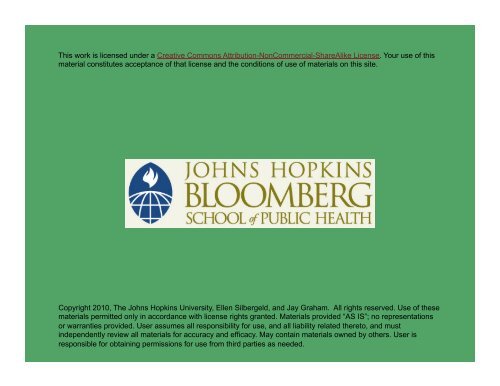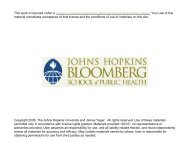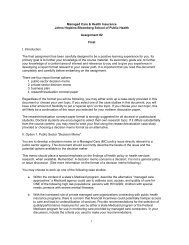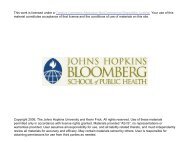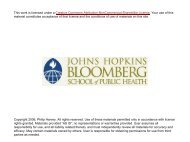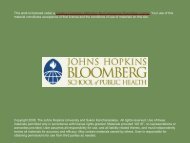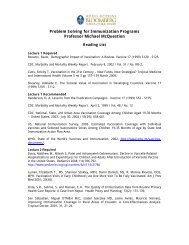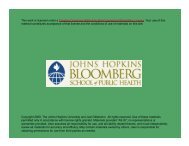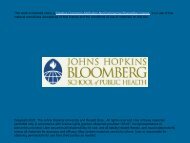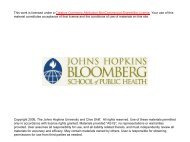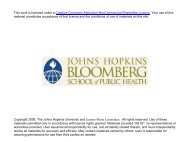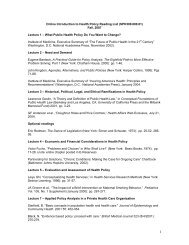Part A - Johns Hopkins Bloomberg School of Public Health
Part A - Johns Hopkins Bloomberg School of Public Health
Part A - Johns Hopkins Bloomberg School of Public Health
You also want an ePaper? Increase the reach of your titles
YUMPU automatically turns print PDFs into web optimized ePapers that Google loves.
This work is licensed under a Creative Commons Attribution-NonCommercial-ShareAlike License. Your use <strong>of</strong> this<br />
material constitutes acceptance <strong>of</strong> that license and the conditions <strong>of</strong> use <strong>of</strong> materials on this site.<br />
Copyright 2010, The <strong>Johns</strong> <strong>Hopkins</strong> University, Ellen Silbergeld, and Jay Graham. All rights reserved. Use <strong>of</strong> these<br />
materials permitted only in accordance with license rights granted. Materials provided “AS IS”; no representations<br />
or warranties provided. User assumes all responsibility for use, and all liability related thereto, and must<br />
independently review all materials for accuracy and efficacy. May contain materials owned by others. User is<br />
responsible for obtaining permissions for use from third parties as needed.
Module 4<br />
Industrial Food Animal Production (IFAP):<br />
<strong>Public</strong> <strong>Health</strong> and Environmental Impacts
What We Know and What We Need to Know about<br />
the Risks <strong>of</strong> Food Animal Production<br />
Ellen K. Silbergeld, PhD<br />
<strong>Johns</strong> <strong>Hopkins</strong> University
Ellen Silbergeld<br />
Pr<strong>of</strong>essor <strong>of</strong> EHS (with joint<br />
appointments in Epidemiology and<br />
in <strong>Health</strong> Policy and Management)<br />
PhD from the Whiting <strong>School</strong> <strong>of</strong><br />
Engineering at JHU, with<br />
postdoctoral training in EHS at<br />
JHSPH<br />
Has held scientific positions at<br />
NIH, the Environmental Defense<br />
Fund, and the University <strong>of</strong><br />
Maryland Medical <strong>School</strong><br />
Consultant and expert advisory<br />
committees for the U.S. EPA, CDC,<br />
National Research Council, NIH,<br />
WHO, ILO, OECD, the World Bank,<br />
UNEP, and UNDP<br />
4
Topics<br />
What is modern industrial food animal production?<br />
What are the critical issues?<br />
What information do we need?<br />
What information do we have?<br />
5
Modern Food Animal Production<br />
Intensive<br />
Confined<br />
Regionally localized<br />
High throughput<br />
Engineered feeds/environments<br />
Product standardization<br />
Outsourcing problems<br />
6
Changes in Food Animal Production<br />
Factory farms—integrated<br />
production model<br />
Concentrated, high-volume<br />
housing and processing<br />
Broad integration <strong>of</strong> food<br />
production and distribution<br />
Image source: USDA.<br />
7
Broiler Production in the United States, 1975–1995<br />
Broiler production (in pounds) and number <strong>of</strong> farms (in thousands) in<br />
the U.S., 1975–1995<br />
Source: USDA/NASS and Census <strong>of</strong> Agriculture, various years.<br />
8
Broiler Production by States<br />
U.S. total: 8.26 billion head<br />
6.94 billion head, 84% U.S. total<br />
All other production states<br />
9
Growth in World Food Production<br />
Data Source: Food and Agriculture Organization<br />
11
Produce Contamination and Human Illness<br />
76 million cases <strong>of</strong> foodborne illness<br />
in the U.S. per year (Mead et al., 1999)<br />
Foodborne illness associated with<br />
produce is increasing over time<br />
13
Epidemiology: Why Don’t We Know More?<br />
Reported antimicrobial-resistant (AMR) infections are the<br />
tip <strong>of</strong> the iceberg<br />
The U.S. National Anti-microbial Resistance Monitoring<br />
System (NARMS), etc., assume food-borne route, do not<br />
fully explore other pathways<br />
14
FDA-Approved Antimicrobials<br />
FDA-approved antimicrobials for growth promotion and<br />
prophylaxis in poultry<br />
Bacitracin<br />
Bambermycin<br />
Carbadox<br />
Roxarsone, arsinilic acid<br />
Chlortetracycline<br />
Enr<strong>of</strong>loxacin<br />
Erythromycin<br />
Laidlomycin<br />
Source: CDC.<br />
Lasalocin<br />
Lincomycin<br />
Monensin<br />
Oxytetracycline<br />
Penicillin<br />
Tiamulin<br />
Tylosin<br />
Virginiamycin<br />
16
Antibiotics, Animals, and Biosolids: A Nexus <strong>of</strong> Concern<br />
All uses <strong>of</strong> antibiotics inevitably select for resistance<br />
Antibiotic-resistant infections are an increasingly serious clinical<br />
problem<br />
The same classes <strong>of</strong> drugs are used in food animal production as in<br />
clinical medicine<br />
18
Quinolone-Resistance<br />
Quinolone-resistance in human<br />
isolates <strong>of</strong> C. jejuni/coli in Spain<br />
Data Source: Smith. (2000). Campylobacter. ASM Press.<br />
20
The Other Product <strong>of</strong> CAFOs<br />
The other product <strong>of</strong> concentrated animal feeding operations<br />
(CAFOs)<br />
Image Source: USDA<br />
21
Why Are We Concerned?<br />
More biosolids applied than<br />
land can handle<br />
Contributes to surface and<br />
groundwater contamination<br />
Increased nutrient run<strong>of</strong>f into<br />
surface waters<br />
Detectable presence <strong>of</strong> drugs<br />
and resistance determinants<br />
in groundwater<br />
USDA NRCS<br />
USGS<br />
23
Releases after Storms—U.S. Hog Farms<br />
This photo has been inserted to replace an image for which<br />
JHSPH OCW could not secure license to use.<br />
24
Tilapia Farm<br />
JHSPH OpenCourseWare has removed this image<br />
because license for its use could not be secured<br />
25
Geographic Focus <strong>of</strong> Farmed Shrimp Production<br />
Data Source: Commonwealth Scientific and Industrial Research Organisation.<br />
26
Shrimp Farming<br />
JHSPH OpenCourseWare has removed these images<br />
because license for their use could not be secured<br />
27
World Farmed Shrimp Production<br />
Source: Commonwealth Scientific and Industrial Research Organisation.<br />
28


